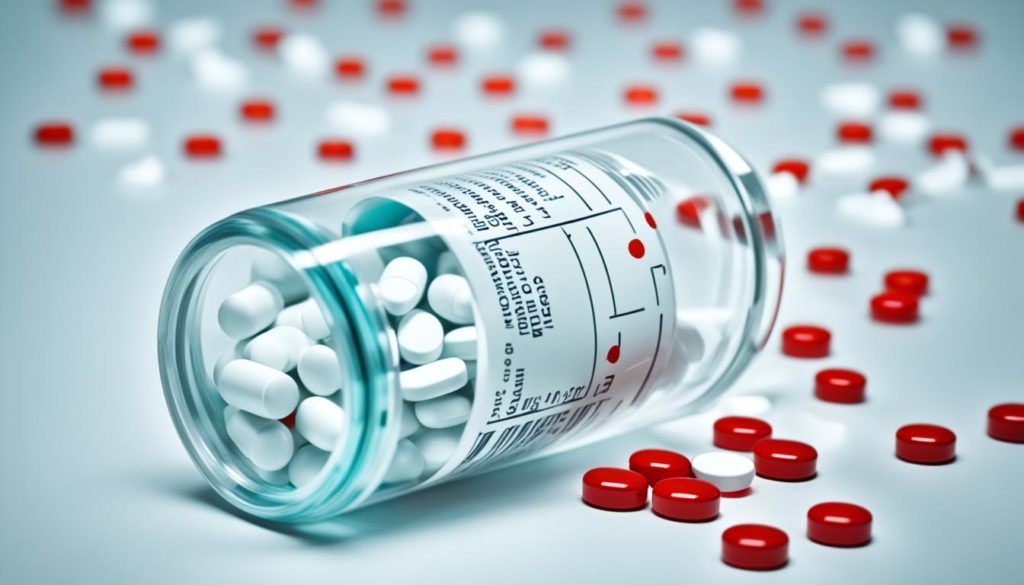Amphetamin, also known as Adderall, is a strong stimulant. It’s mainly used to help people with ADHD and narcolepsy. This drug changes the levels of neurotransmitters in the brain. This helps with focus and staying awake. We’ll look into how it works, its effects, and the risks it comes with.
Key Takeaways
- Amphetamin (Adderall) is crucial in treating ADHD and narcolepsy.
- This controlled substance influences neurotransmitter levels in the brain.
- The drug’s history, mechanism of action, and therapeutic uses are integral for understanding its impacts.
- Proper usage minimizes risks of drug abuse and adverse side effects.
- Being informed about the benefits and risks aids in ensuring safe use.
Introduction to Amphetamin (Adderall)
Amphetamin, also known as Adderall, is a key stimulant medication. It’s often prescribed for Attention Deficit Hyperactivity Disorder (ADHD). Knowing how it works and its differences with similar drugs is important for doctors and patients.

Definition and Chemical Composition
Amphetamin (Adderall) is a stimulant medication. It changes brain chemicals that help control hyperactivity and impulses. The drug combines amphetamine salts in a specific way. This mix helps manage neurotransmitters effectively.
Distinguishing Between Brand Names and Generics
It’s crucial to know the differences between brand-name and generic drugs. Adderall is a brand-name drug with a precise formula. Generics might have different inactive ingredients, affecting how well they work.
Here’s a look at how Adderall and generics compare:
| Aspect | Adderall (Brand-Name) | Generic |
|---|---|---|
| Chemical Structure | Consistent formulation of amphetamine salts | May slightly vary in inactive ingredients |
| Efficacy | High consistency | Potential minor variations |
| Cost | Higher | Generally lower |
Knowing these differences helps patients and doctors make better choices. Whether choosing Adderall or a generic, understanding their differences aids in finding the right treatment.
Historical Background of Amphetamin (Adderall)
Amphetamines were first made in the late 1800s. By the 1920s, people started to see their medical use. They were used for things like stuffy noses and feeling down.
Years went by, and the drug world changed. This led to the creation of Adderall. It’s now a key drug for ADHD treatment.
Early Discovery and Development
Back in the late 19th century, amphetamines were first made. By the 1920s, doctors began to use them for medical issues. They helped with stuffy noses and depression.
Over time, the drug world changed. This led to the creation of Adderall. It’s now a big part of treating ADHD.

Regulatory Approvals and Changes Over Time
The FDA plays a huge role in making sure drugs are safe and work well. Getting FDA approval is tough. Adderall got its FDA approval in the 1990s, making it more accepted in medicine.
But, because it can be abused, it’s a schedule II controlled substance. This means it’s tightly controlled.
Over the years, rules about drugs like Adderall have changed. These changes aim to make sure the drug helps without causing problems like addiction.
Mechanism of Action
Amphetamin (Adderall) boosts alertness and focus by working on the central nervous system (CNS). It does this by affecting neuropharmacology. This means it changes how neurotransmitters work in the brain.
How Amphetamin (Adderall) Affects the Brain
Amphetamin makes the brain work better by increasing neurotransmitters like dopamine and norepinephrine. These chemicals help neurons talk to each other better. This leads to better focus and less impulsiveness.
More dopamine also makes people feel happier and more motivated. This can help with doing tasks better and feeling more productive.
Interaction with Neurotransmitters
Adderall works by changing how neurotransmitters work. It makes more dopamine and norepinephrine available. This makes the brain more active and focused.
It helps with ADHD symptoms by improving attention and reducing hyperactivity. It also makes thinking clearer. The way it affects these brain chemicals is what makes it helpful.
Approved Uses in ADHD Treatment
The FDA has approved Adderall for ADHD in kids and adults. It’s a key part of ADHD treatment. The drug has amphetamine and dextroamphetamine which help focus and reduce impulsivity and hyperactivity.
Effectiveness in Children and Adults
Studies show Adderall works well for ADHD in kids and adults. It helps improve focus and lowers hyperactivity. This drug is crucial for better life quality for those with ADHD.
Dosage and Administration
Adderall’s dosage depends on the person’s needs. For kids, it starts low and increases slowly. Adults may need different amounts. Following the right dose is key for best results and safety.
| Population | Initial Dose | Typical Therapeutic Dose | Max Dose |
|---|---|---|---|
| Children (6-12 years) | 2.5 – 5 mg/day | 10-30 mg/day | 40 mg/day |
| Adolescents (13-17 years) | 10 mg/day | 20-40 mg/day | 40 mg/day |
| Adults (18+ years) | 10-20 mg/day | 20-60 mg/day | 60 mg/day |
By following these guidelines, healthcare providers can give the best care to kids and adults with ADHD.
Therapeutic Use for Narcolepsy
Narcolepsy is a chronic sleep disorder that causes a lot of daytime sleepiness and sudden sleep attacks. To manage this, a special treatment plan is needed. This helps reduce fatigue and keep people awake.
Symptoms and Diagnosis of Narcolepsy
Narcolepsy has symptoms like too much daytime sleepiness, muscle weakness, sleep paralysis, and seeing things while falling asleep. Doctors diagnose it by looking at a patient’s medical history, doing sleep studies, and a test to see how quickly someone falls asleep during the day. Getting the right diagnosis is key for effective treatment.
How Amphetamin (Adderall) Helps
Adderall is a strong stimulant used to help people with narcolepsy stay awake. It changes the brain’s chemistry by increasing dopamine and norepinephrine levels. This helps keep the central nervous system active, reducing daytime sleepiness and helping manage narcolepsy symptoms.
When used right, amphetamines like Adderall are a key part of treating sleep disorders. Doctors must think about each patient’s needs when giving out Adderall. They need to weigh the benefits against the risks to ensure the best care for narcolepsy.
Common Off-label Uses
Amphetamin (Adderall) is often prescribed off-label today. It’s mainly for ADHD and narcolepsy, but doctors also use it to help people focus better in school and work. This has sparked debates about its use as a brain booster.
Cognitive Enhancement and Performance
People use Amphetamin (Adderall) because it makes their brains work better. It helps with focus, memory, and thinking skills. This is why students and workers use it to do more and better.
Studies, like the one in this article, show how common it is for young adults to use Adderall for school or work. Doctors need to watch closely to keep everyone safe.
Potential Benefits and Risks
Using Adderall to help with focus and alertness is tempting. It can make people do better in school or at work. But, it’s not safe for everyone. There are risks like addiction and unknown side effects from using it in ways it’s not meant for.
It’s important to weigh the good and bad sides. Some say it helps with productivity and thinking. But, we need to look at the risks too. Doctors should be careful when prescribing it for off-label use, thinking about patient safety and health in the long run.
There’s a lot to talk about when it comes to Adderall’s benefits and risks. Patients, doctors, and lawmakers need to have open discussions. For more information, this guide offers useful insights.
Risks of Drug Abuse and Addiction
Using amphetamines like Adderall without a doctor’s order is risky. It can lead to drug addiction, even if taken for a medical reason. It’s important for both users and doctors to know these risks.
Understanding the Potential for Misuse
People misuse Adderall to improve focus or stay up longer. This can quickly turn into dependence and addiction. It’s key to tackle the causes of misuse. Adderall misuse can cause serious health problems, needing detailed treatment to help users take back control.
Legal and Health Consequences
Using Adderall without a valid prescription is illegal and can harm your health. It can lead to legal trouble and health issues. Those caught with the drug without a prescription may face serious legal problems.
Using Adderall too much can cause heart problems and mental health issues. The legal issues highlight the need to follow prescription rules to avoid legal trouble.
For those struggling with addiction, there are many treatment options. These include counseling and medication-assisted treatment. They help deal with the complex issues of substance misuse. For more on health strategies, check out the latest healthcare advances.
Side Effects and Safety Concerns
Understanding the side effects of amphetamines like Adderall is key. It’s important to look at both short-term and long-term effects on health.
Short-term Side Effects
Many people feel less hungry, have a dry mouth, upset stomach, and trouble sleeping after taking Adderall. These issues can be managed with the right strategies. It’s crucial to tell a healthcare provider about any problems. Keeping an eye on blood pressure is also important to catch high blood pressure early.
Long-term Health Impact
Using Adderall for a long time can be risky. Users may see mood changes or act differently. In rare cases, they might face serotonin syndrome or allergic reactions, which need quick medical help. It’s important to talk to doctors about ongoing side effects.
For a full list of possible side effects and safety issues, check the WebMD page.
Managing side effects well is crucial. Doctors should keep a close watch on patients, especially those on long-term meds. This helps spot and treat serious problems early.
In short, knowing about the side effects and long-term risks of Adderall is key to staying safe. Good management helps both patients and doctors handle this drug better.
Considerations for Safe Use
Using Amphetamin (Adderall) safely means following the doctor’s guidelines closely. This ensures the drug works best and lowers risks. It’s important to stick to the dosage given to avoid bad effects and addiction.
Regular check-ups are key to using amphetamines safely. They let doctors see how the drug is working and make changes if needed. These visits help spot misuse or bad reactions early. Doctors set these check-ups to keep patients healthy and get the best results.
It’s crucial to know how Amphetamin (Adderall) might interact with other drugs. Some can make its effects stronger or weaker, causing problems. Always tell your doctor about all the medicines you take to avoid bad reactions. For more info, check out this health guide.
Teaching patients about safe use is vital. By educating them on the risks of misuse and the need to follow the rules, we can lower risks. Patients should know how to use the medicine right, spot misuse, and talk to their doctor if they have concerns.
| Safety Measure | Importance | Action Required |
|---|---|---|
| Prescription Guidelines | Ensures correct dosage and efficacy | Follow doctor’s instructions strictly |
| Monitoring Protocols | Detects misuse and adverse effects early | Regular medical check-ups |
| Drug Interactions | Prevents harmful interactions | Inform doctor about all medications |
| Patient Education | Promotes responsible use | Understand and recognize misuse signs |
By following these steps, patients can use Amphetamin (Adderall) safely and effectively. This helps reduce risks.
Conclusion
Amphetamin, also known as Adderall, has a big role in ADHD care and more. It was first found and now helps many people with ADHD and narcolepsy live better lives. Knowing how it works and how to use it safely is key for doctors and patients.
This article showed how important it is to use Adderall safely, especially for ADHD. Adderall works well but can be misused, leading to health problems. Using it with other treatments and making healthy lifestyle changes is best for good results.
In short, handling Adderall requires a careful approach. Understanding its good and bad sides helps make treatment better. For more tips on staying healthy, check out this guide on overall wellness.
FAQ
What is Amphetamine (Adderall) and its primary uses?
Amphetamine, known as Adderall, is a stimulant used for ADHD and narcolepsy. It’s a controlled substance that needs a prescription.
How does Amphetamine (Adderall) work in the brain?
Adderall boosts certain brain chemicals like dopamine and norepinephrine. This helps people with ADHD focus better and control impulses. It also helps people with narcolepsy stay awake.
What are the differences between brand-name Adderall and generic versions?
Brand-name and generic Adderall have the same active ingredients. But, they might differ in inactive ingredients, affecting how well they work for some people. Still, generics are usually as effective as the brand-name version.
What are the common side effects of taking Amphetamine (Adderall)?
Short-term side effects include a faster heart rate, high blood pressure, dry mouth, trouble sleeping, and less hunger. Long-term use can cause serious health issues like heart problems and mental health issues.
What is the history behind the development of Amphetamine (Adderall)?
Amphetamines were found in the early 1900s for medical use. Adderall got FDA approval for ADHD treatment. Over time, its prescription rules got stricter due to abuse concerns.
How effective is Amphetamine (Adderall) for ADHD treatment in children and adults?
Studies and real-world use show Adderall helps manage ADHD in kids and adults. It’s important to take it as prescribed and check in with a doctor to work well and avoid side effects.
Can Amphetamine (Adderall) be used to treat narcolepsy?
Yes, doctors also prescribe Adderall for narcolepsy. It helps people stay awake by stimulating the brain.
Are there any off-label uses for Amphetamine (Adderall)?
Adderall is sometimes used for more than ADHD and narcolepsy, like to boost focus and performance. But, this is risky and can lead to addiction and health problems.
What are the risks associated with abusing Amphetamine (Adderall)?
Using Adderall without a prescription is dangerous. It can lead to addiction, heart issues, and mental health problems. It’s illegal and can ruin your life.
How can one use Amphetamine (Adderall) safely?
Use Adderall safely by following the doctor’s dosage, having regular check-ups, and learning about the drug’s effects. Watch for any bad reactions to stay safe.


